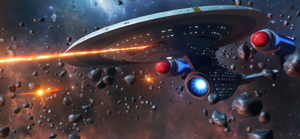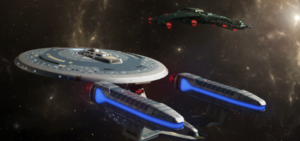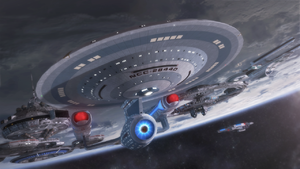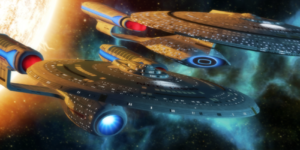Ambassador Class
More actions
The Ambassador-class emissary has served Starfleet as a venerable workhorse since the first quarter of the 24th century. Over their decades of service, they have served in many roles. Originally designated as the first class of explorer-type vessels in Starfleet, they were gradually pulled back from most frontline operations and served capably as diplomatic, scientific, and tactical platforms for duties within Federation space as exploratory cruisers following the introduction of the Galaxy class of explorers in the early 2360s. By the 2380s, they were considered heavy cruisers, and in 2400 Starfleet moved to transfer them to Starfleet Auxiliary in disarmed roles. This decision was reversed in 2401, because of a desperate need to shore up the fleet following Frontier Day. The disarmament process was halted and the remaining Ambassador-class starships have reentered service now designated as emissaries, focusing primarily on diplomatic and humanitarian missions to allow more modern vessels to take scientific and tactical duties.
Science and Exploration
The Ambassador-class starship was intended to be as revolutionary to the exploration of space as the Constitution was in her time; an order of magnitude more capable than the Excelsior-class ships serving as Starfleet’s premiere exploratory vessels in the 2330s. Indeed, this class was the first to be designated as an explorer rather than as a cruiser, given that she was designed to undertake true five-year unsupported missions outside of Federation space.
By the early 2370s, she had been reclassified as an exploratory cruiser but retained impressive scientific and exploratory capabilities that have continued to make her a desirable command. The class contained the most powerful spaceborne sensor arrays of their time, and her eighteen modular sensor pallets continue to be able to use the latest scientific scanner equipment. Twenty-eight large dedicated laboratory facilities are included in the ship, along with facilities to convert three of the cargo bays to hold extra scientific equipment if necessary. This gave the Ambassador an estimated 325% increase in research capabilities over an Excelsior, and she remains significantly more capable than light cruisers and smaller, more modern-exploratory vessels.
As of 2401, the remaining Ambassador-class starships in mainline service have been retrofitted with modern scientific equipment. As their role is primarily diplomatic and humanitarian, Ambassador-class ships' science departments are often working on data analysis and other independent projects secondary to the ship's primary mission.
Diplomacy
As her name would suggest, an Ambassador-class starship are of the most capable diplomatic platforms in Starfleet and remain an excellence choice for most diplomatic missions in and near Federation space when an Obena or Odyssey-class ship is not available. She was one of the first classes to include extensive support for variable atmosphere and gravity accommodations to assist in diplomatic dealings with lifeforms who are not from M-class environments. A full 50% of her high-quality guest quarters and all of her elaborate conference facilities were originally able of being quickly configured for K, L, O, or P-class environments, and this capability was extended in the 2370s to include high-temperature environments. Most vessels of this type have also been retrofitted with holographic projectors either in the whole ship or in diplomatic areas to allow for quick reconfiguration of facilities for different negotiations. An Ambassador-class ship is capable of hosting multi-party talks in great comfort, while also being a suitably-powerful ship to not need an escort when going into hostile areas.
When they reentered service in 2401, Ambassador-class ships were designated formally as emissaries, the diplomatic and humanitarian equivalent to explorer-type starships. Working alongside their much newer Obena-class counterparts, these revamped Ambassadors work to shore up internal and external relations for the Federation, so that newer and more advanced cruisers can be sent on defensive and exploratory missions instead. Where possible, they have been given a literal and metaphorical fresh coat of paint—new finishes, new furniture, and new communications equipment—while retaining their original grand and sophisticated design features, such as dedicated ballrooms, concert halls, and the like.
Engineering
Ambassador-class ships were among the fastest vessels of their time, retaining speed records that weren’t broken until the Galaxy-class was launched in the late 2350s. These vessels were the first to use the second generation of the semi-toroid warp coils that became standard after the launch of the Excelsior-class three decades earlier. Their large warp cores provided ample power for her scientific and tactical systems as well, and they boast large engineering crews to keep everything operating effectively. Now, Starfleet's decades of experience with this ship have allowed them to reduce the engineering crew complements substantially, leaving more room for scientific, diplomatic, and humanitarian personnel.
An Ambassador-class ship also maintains relatively large cargo bays and auxiliary craft facilities, alongside industrial replicators and other systems that made her a very effective vessel for humanitarian missions or construction projects. As emissaries, these ships can deliver massive amounts of humanitarian aid, including prefabricated hospital modules, industrial replicators, and other instruments of the Federation's mercy.
Compared to newer starships, more of an Ambassador's maintenance needs are manual, even with increased automation. Her overall sprint capabilities are also lower. Given the age of the systems on this class, individual vessels may have quirks and issues not expected in modern ships. These vessels often have several different generations of technology working together, such as isolinear main computers interfacing with first-gen bioneural systems in some computer labs, which then connect to bioneural-isolinear control arrays in the new communications systems. Managing these cross-generational systems can be very challenging.
Tactical

The Type-IX phaser array was developed for use aboard the Ambassador. This measure greatly increased the ability of the Ambassador Class to fire sustained bursts and greatly reduced the recharge and cool down times. The use of an independent power system for every group of ten emitter segments in the array triples the survivability of the array compared to a ball turret, while there are also benefits to the reaction time, greater control of thermal effects, field halos, and target impact. Overall the phaser arrays of the Ambassador were over 50% more effective than the Type-VIII ball turrets found aboard Excelsior-class ships. Torpedo coverage was achieved with a single burst-fire torpedo tube forward and another aft.
Ambassador-class ships performed well in the Cardassian, Klingon, and Dominion conflicts of the mid-24th century, even being 40 years old. They had a much higher survivability rate during the Dominion War than the Excelsior class did, and their greater size and power generation capabilities allowed them to be retrofit with Type-X phasers and more advanced torpedo launchers in the years after the war. As of 2401, Ambassador-class starships retain their Dominion War-era armaments, which make them pound-for-pound matches for most cruiser-sized vessels of other regional powers, but they are now generally reserved for diplomatic duties.
Shipboard Life
As with many designs that were once launched as flagships, the Ambassador-class is now a reliable workhorse for the Federation. Crews aboard these ships tend to enjoy their assignment, as the class has been retrofitted with most of the amenities you would find aboard newer explorers, such as holodecks, arboretums, and lounges, as well as comfortable crew quarters. While not as luxurious as the ships built as part of the Galaxy program, they are less austere than most of the starship classes currently in production and have a certain nostalgic factor in their appeal. Though they are old starships, they typically have experienced captains who are prepared to engage in serious diplomatic talks or experienced humanitarians who can coordinate vast deliveries of supplies to the Federation's allies.
As part of their anticipated conversion to Starfleet Auxiliary service, a hospital ship variant of the Ambassador-class was developed. Some of these modifications have been incorporated into mainline vessels as well, and provisions have been made to convert scientific facilities and guest quarters into additional patient facilities if needed. A large sickbay complex in the saucer section provides for excellent crew care, though it doesn't quite reach the standard found aboard Obena or Odyssey-class vessels.
Class History

Initially envisioned as early as 2300, the Ambassador-class was designed as not only the next greatest exploratory ship for Starfleet but also as the first of an entirely new classification of starship: explorer, as opposed to a mere heavy cruiser. Development was done at a relatively slow pace, given that the Federation was in a sustained period of peace and the Excelsior-class was performing above expectations. Starfleet wanted a design that would introduce as many revolutionary systems as her predecessor had, which led to a long prototyping period with other less-capable ships, such as the Renaissance-class light cruiser and the Freedom-class frigate. These technologies included the next generation in warp coils, phasers, shields, and scientific systems, as well as diplomatic facilities that would make the Ambassador a powerful symbol of the Federation’s values.
Construction on Ambassador, Surak (renamed Enterprise before launch, while the name Surak was transferred to a second-run vessel of the same class), and Zheng He began in 2323 at Utopia Planitia Fleet Yards. Ambassador was launched in 2329, followed by her sister ships in 2332 and 2333, respectively. Despite retaining a crew size of 750, they required nearly twice the time and twice the resources of an Excelsior-class starship, while only giving approximately a 50% improvement in overall capabilities. Though they were markedly better at scientific and diplomatic missions, they were too expensive to replace the Excelsior in her role as a capable multi-mission platform, and both classes continued to be produced alongside one another until Excelsior and Ambassador were replaced by the Nebula-class in 2355 and the Galaxy-class in 2358, respectively.

During her production run, the Ambassador-class was generally built at a rate of two units per year, with 75 of the class built in total. This made them rare compared to the Excelsior-class which was built in the hundreds and they were generally reserved for high-status assignments. They proved popular in service to both their crews and to the admiralty, though they were eclipsed by the Galaxy-class which was substantially more powerful and useful in every respect.
They were generally a rare sight within the Federation for the first thirty years of their lifespans, as they were sent on long-range missions or reserved to put out diplomatic brushfires, but they gradually became more and more common within the core as they were supplanted. One was lost at the Battle of Wolf 359, and a handful were destroyed during the Dominion War, but they proved to be substantially tougher than the Excelsior thanks to their more powerful shields, something that was simply less important to the Federation during their initial production run.
By the end of the 24th century, the oldest Ambassador-class ships were over seventy years old. While the class was built with a centennial lifespan in mind, it was determined that the remaining decades of their effective service life would be more beneficial to the Federation as part of Starfleet Auxiliary, rather than continuing in mainline service, given that there were multiple newer, faster cruiser classes now in service. Other than the ex-USS Adelphi, renamed the USS Edwin H. Armstrong, modernized, and retained as a technological testbed at Avalon Fleet Yards, the other ships of this class were to be disarmed and refit as medical vessels and fast transports to supplement the fleet of Olympic-class vessels in auxiliary service. This process began formally in 2400, but that decision was reversed in 2401 following the devastating losses suffered by the fleet over Earth during Frontier Day.

Starfleet ordered the disarmament process on the Ambassador class halted, as the fleet had gaps that needed to be filled immediately. Indeed, the older computer systems aboard the Ambassador were considered a plus, as they would have no risk of any lingering connection to Fleet Formation Mode. While they couldn't be quickly brought back into service as true heavy cruisers to match their more modern cousins, Starfleet Operations saw an opportunity to designated them as emissaries to take on complex diplomatic and humanitarian missions alongside the Obena class, which would let other large vessels focus on the tactical and exploratory missions that the Ambassador was no longer as well suited for. In the months following Frontier Day, many Ambassador-class ships have been brought back into mainline service, and they are expected to remain there for the foreseeable future.
In Play
- Ambassador-class ships were capable heavy cruisers built in smaller numbers than the older Excelsior, but still relatively common. Functionally, they had a lot in common with the Galaxy-class, but the newer ship eclipsed it in every measure. Because of this, the Ambassador was a solid, relatively-generic heavy cruiser that could go on nearly any mission and expect to perform adequately. They wouldn't often be sent on long-range missions alone anymore.
- An emissary is like a courier, but much larger. Ambassador-class starships do as their name suggests: they perform important diplomatic functions in and around Federation space, negotiating with the Federation's allies and trying to make the galaxy a safer place through diplomacy. They also perform humanitarian functions.
- These ships are old, but they're not second rate. Pound-for-pound, they're just as capable as ships from the 2360s and 2370s, though they do lag behind the most modern ships. They have good bones, large, powerful warp cores, and 70+ years of experience in the technical manuals on how to get them to their full potential.
